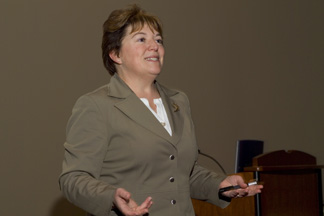What's lurking in your refrigerator can be a 'serious public health problem,' Cornell professor says
By Sandra Holley

Americans suffer from some 76 million cases of food-borne diseases (FBDs) each year. And some of the associated bacteria can have lasting health consequences, according to Kathryn Boor, Cornell associate professor of food science.
Presenting a public lecture March 15, Boor described how Listeria can cause pregnancy loss and how E. coli O571:H7 has become the leading cause of acute kidney failure in children in the United States.
And because only one out of four infected people ever seek medical care, "we probably underestimate the burden of food-borne illnesses in the U.S.," said Boor, in the Boyce Thompson Institute auditorium speaking on "What's Lurking in Your Refrigerator: New Tools for Protecting the Safety of Our Food." The talk was hosted by the Cornell Campus Club.
FBDs are a serious public health problem, she said, pointing out that "mad cow" and foot-and-mouth diseases are back in the news in Alabama and Great Britain, respectively, as is E. coli O157:H7 found in raw milk and raw apple juice elsewhere in the United States, including upstate New York.
"All these things tend to make us feel quite anxious about the safety of the food that we eat," reported Boor, who is director of the Food Safety Laboratory at Cornell.
Some of the outbreaks are triggered by people carrying animal-based food products from other countries. That was the case with the foot-and-mouth disease outbreak in the United Kingdom that started when someone brought sausage into the country illegally and fed the scraps to pigs.
International trade, mass production and the demand for lightly processed foods also contribute to FBDs entering the food supply. For example, Americans enjoy exotic fruits and vegetables regardless of the season, such as strawberries in the middle of the winter available in such small towns as Horseheads, N.Y., where Boor grew up.
"And, they are not grown in Chemung County," said Boor. "They are being sourced from all over the world. As a consequence, we are also exposing ourselves to greater opportunities of encountering foods that may have been contaminated, due to the complexity of [food] coming to us from faraway places."
One of the major problems, she said, is recognizing harmful strains of bacteria. There are "good" E. coli and there are "really bad" E. coli, but they all look alike under a microscope. However, even if they share the same name, they may share as little as 70 percent of the same genetic material. That means 30 percent of the genetic material in an organism enables researchers to figure out the good from the bad. Her laboratory, for example, she said, is on the cutting edge of using these genetic differences to tell bacteria apart.
The Cornell Campus Club, a century-old organization, can be contacted through http://www.campusclub.cornell.edu/ or Anita Watkins at aw236@cornell.edu.
Graduate student Sandra Holley is a writer intern at the Cornell News Service.
Get Cornell news delivered right to your inbox.
Subscribe